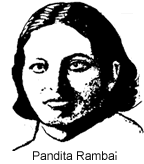
Dimdima
Online Children's Magazine from India

Dimdima
Online Children's Magazine from India
| Women : Crossing the Threshold |
|
In the 1890's when two friends Kashibai Kanitkar and Anandibai Joshi stepped
out of their homes wearing shoes and carrying umbrellas they were pelted with
stones. Within a decade Kashibai Kanitkar started writing novels in Marathi
and Anandibai qualified as a doctor in America. |
The first schools for girls had been started at the beginning of the 19th
century by Christian missionaries. By the middle of the century,
progressive-minded Indians in all parts of the country but especially in Bengal,
began to advocate education for women.
In Maharashtra, Jyotirao Phule founded the first school for women in Pune.
Predictably there was opposition to the move to open up education for girls. When Ananta Shastri of Maharashtra
began to teach Sanskrit to his wife Laxmibai, the villagers boycotted the
couple. The couple had to build a house in the forest where their daughter
Ramabai was born in 1858.
the move to open up education for girls. When Ananta Shastri of Maharashtra
began to teach Sanskrit to his wife Laxmibai, the villagers boycotted the
couple. The couple had to build a house in the forest where their daughter
Ramabai was born in 1858.
Pandita Ramabai grew up to become a champion of women's education. She attended
the 1889 Congress in Mumbai, along with 9 other ladies.
The women delegates were not allowed to speak or vote on resolutions at this
session. However, in the 1890 session, a woman delegate was allowed to speak and
she is reported to have thanked the President for granting her the privilege.
It took another 40 years for women in Bengal to shed the purdah. A group of
Brahmo women took the lead by walking through the streets of Calcutta with their
faces uncovered and singing loudly.
 One
of the first women activists was Sarala Debi Ghoshal, a niece of poet
Rabindranath Tagore. After graduation, at the age of 23, Sarala Debi left home
in 1894 and took up a job as Asst. Superintendent at a girl's school in distant
Mysore. She chose to leave her home because she 'wanted to flee the cage or
prison of home, and establish her right to an independent livelihood like men.'
On her return to Calcutta she became the editor of Bharati, a monthly journal.
In 1904, Sarala Debi trained a group to sing Bande Mataram at the Congress
session held in Calcutta. It was Sarala Debi who initiated the move to use the
words Bande Mataram as a national call, thus preparing the ground for women to
participate in the struggle for freedom.
One
of the first women activists was Sarala Debi Ghoshal, a niece of poet
Rabindranath Tagore. After graduation, at the age of 23, Sarala Debi left home
in 1894 and took up a job as Asst. Superintendent at a girl's school in distant
Mysore. She chose to leave her home because she 'wanted to flee the cage or
prison of home, and establish her right to an independent livelihood like men.'
On her return to Calcutta she became the editor of Bharati, a monthly journal.
In 1904, Sarala Debi trained a group to sing Bande Mataram at the Congress
session held in Calcutta. It was Sarala Debi who initiated the move to use the
words Bande Mataram as a national call, thus preparing the ground for women to
participate in the struggle for freedom.
Dimdima is the Sanskrit word for ‘drumbeat’. In olden days, victory in battle was heralded by the beat of drums or any important news to be conveyed to the people used to be accompanied with drumbeats.
Bharatiya Vidya Bhavan
K. M Munshi Marg,
Chowpatty, Mumbai - 400 007
email : editor@dimdima.com
Bharatiya Vidya Bhavan
505, Sane Guruji Marg,
Tardeo, Mumbai - 400 034
email : promo@dimdima.com
Dimdima.com, the Children's Website of Bharatiya Vidya Bhavan launched in 2000 and came out with a Printed version of Dimdima Magazine in 2004. At present the Printed Version have more than 35,000 subscribers from India and Abroad.